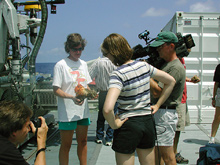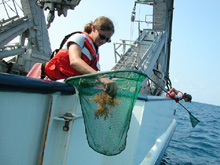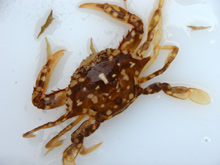
Ten media representatives, including 2 people from NOAA, were invited to tour the R/V Seward Johnson while it was out at sea. Photo credit: Kristin Heron. Click image for larger view.
Planning on the Fly
August 20, 2003
Margot Bohan
NOAA Office of Ocean Exploration
Well, today was the day; the long anticipated media site visit was happening at last. Arrangements had been made for this event well in advance. All our "ducks were in a row," and the weather couldn’t be more ideal. We were ready for the day’s activities, as outlined:
- 8 am Deploy Johnson-Sea-Link II for 3-hour morning dive;
- 11 am Recover JSL II in conjunction with the arrival of the University of North Carolina’s research vessel (R/V) Cape Fear carrying members of the North Carolina media, NOAA, and NC SeaGrant. The Cape Fear will remain off the ship’s stern as the JSL II is brought on deck;
- 11:30 am Ferry the attendees aboard for a tour, lunch, and visit with scientists;
- 2:30 pm Steam to the southwestern corner of a proposed marine protected area (MPA) site;
- 3 pm Deploy JSL II for afternoon dive.

Martha Nizinski, a zoologist with NOAA Fisheries' National Systematiics Lab, is interviewed by a representative from University of North Carolina TV. Click image for larger view.
The R/V Cape Fear was ahead of schedule and expected to arrive two hours early. If we tried to launch the JSL II at that point, with the media boat so close, the main attraction, i.e., the submersible, would be underwater throughout the entire site visit. Thankfully, with this science team, options and flexibility abound. We held off on deploying the sub until the Cape Fear drew near enough to observe. Agreement was also reached to curtail the morning dive so that the site visit attendees could observe the sub's recovery and examine the various invertebrates and fish collected within the timespan of their visit. Once the sub was down, the site visit attendees came aboard the ship for lunch, conversation, a tour of the ship, and JSL II viewing.
Also joining us on the ship today was Art Howard, a photographer and the final member of our science party to arrive; he was just coming off a filming trip in the Galapagos, but didn’t want to miss out on this adventure. A high-definition videographer, Art is on board recording the daily routines of the science team as well as participating in some of the submersible dives. His footage will be used to create a high-definition movie for the North Carolina Museum of Natural Sciences.

Members of the “Life on the Edge” expedition dip netting for Sargassum off the ship’s stern. Photo credit: Art Howard, NAPRO. Click image for larger view.
After the media event drew to a close, we prepared to explore the proposed MPA site with an afternoon JSL II dive. We steamed one hour to the site in anticipation of new finds, only to discover that a commercial fishing boat was working the spot we had selected earlier. It was too dangerous to deploy the sub with fishing nets and lines in the vicinity, so we modified our plan once again and decided to steam back toward the northeast.
In mid-transit, several of us spotted a huge mass of Sargassum (a very large brown seaweed). We called the bridge and asked the first mate if we could once again readjust our plan and steer toward the Sargassum to sample it. He gave the OK, so we went there and took dip net samples. The Sargassum itself and the fish and invertebrates that live within it were sorted and worked up in the wet lab. Then we were on our way again.
Finally, we deployed the JSL II and had a late but very successful dive that revealed small patches of coral, various reef fishes, including several lionfish, and many rocky features. Various net tows continued into the night as the R/V Seward Johnson prepared to leave the proposed MPA area and head into deeper waters of the Southern Lophelia Banks.

Check out the essay on sargassum and open water communities within this Website to learn more about organisms, such as this Portunid crab, that often make Sargassum mats their home. Photo credit: Liz Baird. Click image for larger view.
Planning on the fly is the name of the game, it seems, when conducting a research expedition at sea. We made the best out of what otherwise could have been a difficult and frustrating day. Options clearly can provide opportunities -- a lesson that can be applied to all facets of life.





















